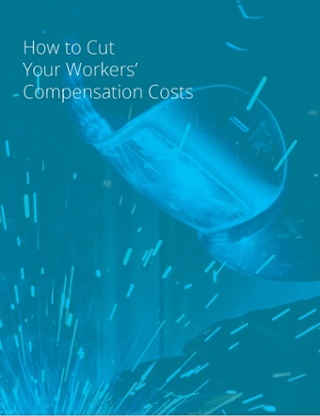Regardless of the industry you operate in, you almost certainly need to have workers’ compensation insurance coverage if you run a business of any size. While some states exempt very small businesses from this requirement, that does not remove your liability to pay if an employee or contractor is injured on the job.
The cost of workers’ comp can be quite high, though, particularly if you work in a high-risk field, and so it’s important to understand what steps to take and what to look for when you’re ready to purchase a workers’ compensation insurance policy.
CHAPTER 1: UNDERSTAND YOUR RESPONSIBILITIES
The first thing to consider when you’re researching workers’ comp policies are the specific state requirements you’ll need to follow. While only Texas truly makes this type of coverage optional for all businesses, the specific regulations concerning which companies must have it and what benefits it provides can vary from one state to the next.
 A few states don’t require a business to carry workers’ comp insurance if they have only a few employees, although contractors are often treated as employees with respect to workers’ compensation claims. That means that if you have a contractor working for you, and they don’t have their own workers’ compensation insurance, you’ll be liable if they’re injured on the job. It’s also important to remember that, regardless of whether you need to carry coverage, you’re still responsible for settling all workers’ comp claims involving your employees.
A few states don’t require a business to carry workers’ comp insurance if they have only a few employees, although contractors are often treated as employees with respect to workers’ compensation claims. That means that if you have a contractor working for you, and they don’t have their own workers’ compensation insurance, you’ll be liable if they’re injured on the job. It’s also important to remember that, regardless of whether you need to carry coverage, you’re still responsible for settling all workers’ comp claims involving your employees.
State-run Funds
While most states allow you to select your own carrier for workers’ compensation insurance, a few require you to use their state-run funds for your coverage. Other states, sometimes referred to as monopoly states, operate state-run funds but don’t require that everyone use them, and some offer no state-run option at all. To make sure you’re fully protected, you need to know what the rules are for each state your employees work in, even if they’re based somewhere else and only travel into that state occasionally for a specific job.
This is particularly important if you’re based in a state that allows you to insure through a private company but your employees sometimes work in a monopoly state. There’s no way that a private insurer can cover you there and properly satisfy the requirements for coverage. Even if you operate in five states and one of them is a monopoly state, you can acquire a private policy that covers the four other states, but you’ll still have to go through the state-fund of the monopoly state to be fully protected.
CHAPTER 2: LEARN ABOUT POLICIES
Before you begin exploring your coverage options, it’s important to know what workers’ compensation insurance is and what it covers. The specifics of these policies are determined in large part by the state your business is operating in, and so there is not a lot of variation from one carrier to the next in terms of what is covered.
Types of Coverage
Essentially, a workers’ comp policy is made up of two parts. The first part will cover the expenses an employer is liable for if any employee is injured on the job or made ill due to work-related exposure. There is no limit on the benefits paid to the employee, and if an accident results in an employee’s death, benefits will be paid to their dependents.

The second part of a typical worker’s comp policy is also referred to as the employers’ liability, and it covers you if a worker not covered under part one of your policy is injured. There are exclusions from primary workers’ comp coverage for some types of employees in some states, and so the employers’ liability section of your policy would pay for these types of claims.
Part two also protects you if one of your employees sues a third party over a work-related injury and that third party seeks compensation from your company. There is always a limit to the coverage provided under part two of your workers’ comp policy, though, and so it’s important that you know what that is so that you can properly coordinate it with your umbrella insurance if you have it.
Cost Structures
Most insurers will charge a yearly premium for your workers’ comp insurance, and they arrive at that amount by evaluating a variety of factors, while also considering the state requirements and regulations concerning the type of business you are and the classification of your employees. In general, this means assigning each employee classification code a risk based on the likelihood of them being injured on the job, and multiplying these by your payroll in $100 increments.
Your company’s claims history will also play a role in determining your final premium cost, as an incidence higher than average for your industry will result in a higher rate, and a good safety record can cause your premiums to decrease. The number used to adjust your base premium in this way is called the experience modification factor, or ExMod, and every company starts with a value of 1.00. The location, structure, and age of your business will also play a role in calculating your ExMod, as will the details of your safety processes and procedures.
Alternative Options
There are several alternative cost structures that you may want to explore if you’re attempting to reduce your workers’ compensation costs. One is a large deductible plan, under which you as the employer would be responsible for all benefits required under a claim until the deductible was satisfied. At that point, the insurer would assume total responsibility for any additional payments on that claim. These types of policies typically have a yearly maximum that the insured is responsible for as well, and once that was reached, the carrier would handle any additional claims in full.
Another option is a retrospective rating plan. With this type of policy, you would pay a standard premium at the start of the coverage period, and then either pay extra or be reimbursed at the period end based on the cost of claims filed during that time frame. Both alternative cost structures are beneficial in certain specific situations, and so they’re worth learning about. But it’s important that you also make sure you have adequate coverage to protect your company as well as to satisfy all state requirements.
Additional Policies
In addition to your workers’ compensation insurance, you may want to invest in some other types of coverage to ensure you’re fully protected. For instance, an umbrella policy is often a good idea, particularly because it extends your coverage on more than just your workers’ comp policy.
An umbrella policy will kick in if a claim exceeds your maximum on part two of your workers’ compensation policy, but it will also cover overages on your general liability policy. These policies are typically quite affordable, especially when compared with the cost of raising the limits on all your other policies individually, but you do have to make sure that those limits are properly aligned so that when you reach them, the umbrella coverage will immediately activate.
If you employ people in more than one state, or if your workers frequently cross state lines to work, you need to make sure that they are covered appropriately. The regulations concerning coverage and premium calculation are often different in each state, and because of this, you may or may not be able to use the same carrier for all areas in which your employees work. However, regardless of the details, it’s important to make sure that no matter where work is performed, your employees are adequately covered.
CHAPTER 3: RESEARCH COMPANIES
When it comes to getting the best rates and comprehensive coverage for your company, knowing your options is essential. Before you even begin talking to an agent, you should know who the insurers are that provide coverage in your state. Ideally, you’d like to work with an insurance company that regularly deals with your industry, so you can be sure they’re appropriately assessing your risk and charging you a rate commensurate to that.

In addition to private insurers, it’s good to know if a state-run fund exists in your state, even if you’re not required to use it. In some states, the state-run fund must compete with private insurers, and so it’s worth finding out what they offer. It’s also important to know that coverage from a state-run fund will not cover your employees if they’re working in another state, and so you must arrange separate coverage for them based on the regulations there.
Group Self-insurance and PEOs
Some other alternatives for acquiring workers’ comp coverage include group self-insurance and Professional Employer Organizations (PEO). These are often attractive options for small businesses, although not all states will allow you to use group self-insurance for your workers’ comp policy. That’s largely because these groups may or may not remain financially stable, increasing the risk that they will not be able to adequately meet their claims obligations at some point down the line.
Obtaining a policy through a PEO, on the other hand, is perfectly acceptable in most states, although you do need to pay attention to the type of policy you’re signing up for. Workers’ comp coverage through a PEO will either be in the form of a Multiple Coordinated Policy (MCP) or a Master Policy, and the type you get can significantly impact how much you pay.
That’s because a Master Policy will use the same ExMod, for each company in the PEO regardless of their individual claims history. If all members of the PEO are safety-conscious and have generally good records, this won’t necessarily be a problem. But it also means that there’s little you can do to lower your rates, or even prevent them from going up because of multiple claims from other companies in the organization.
On the other hand, there is little difference between acquiring coverage through an MCP as part of a PEO and purchasing an individual policy on the open market, aside from the benefit of lower negotiated rates due to your membership in the PEO. This type of policy will calculate your premiums based on your company’s specific claims history, and the PEO will handle the processing of claims and the administering of benefits for you so that you don’t have to.
CHAPTER 4: GET AN AGENT
Having a good insurance agent to work with when you’re buying workers’ compensation insurance can have a huge impact on the rates you pay, as well as on the experience you have over time. In general, the agent you deal with will either work for an agency that contracts with multiple insurers, or be employed by a specific insurer. In the case of the latter, they will only be able to provide coverage through that carrier.

When choosing the type of agent you’d like to work with, it’s worth considering how much research of individual companies you want to take on yourself. If you’re comfortable selecting the specific insurer you’d like to deal with, finding an agent employed by that company is probably the best option. However, if you want to have an agent who can gather quotes for you from multiple insurers and then set you up with the one that’s the best fit for your situation, you’re better off looking at the agency option.
The Right Experience
Once you know what kind of agent you’d like to work with, you can begin looking for someone with the experience that best matches your situation as well. For starters, you want someone who has worked primarily with commercial policies as opposed to personal ones, and preferably, someone who has specific experience handling workers’ compensation insurance.
Because workers’ comp is different from other types of business insurance in several ways, setting up the policy and managing it appropriately can be confusing for an agent not familiar with the system. And because the responsibility for assigning classification codes to your workers and ensuring the proper ExMods are used falls on the agent, their level of expertise can directly impact how much you pay in premiums.

Ideally, you’ll also find an agent with at least some specific experience working with companies in your industry. The risks assigned to your workers are directly related to the industry you operate in and the kind of work you do, and so it’s good to have someone handling your policy who has a clear understanding of these factors. Similarly, if you operate in multiple states, or if your workers frequently travel to other states to work, you want an agent familiar with the myriad regulations you need to follow to maintain comprehensive coverage across your entire operational area.
Additional Assistance
Of course, setting up your initial workers’ comp policy doesn’t mean the work is done. Particularly for smaller employers, the challenges of resolving problems with claims when they arise and ensuring that your premiums are properly calculated from one year to the next can be taxing. Because of this, you’ll want to select an insurance agent with the resources to help you in these types of situations, and the best way to know if this is the case is simply to ask a prospective agent before you enter an agreement with them.
Similarly, it’s a good idea to ask about the process for reviewing your business annually, as well as whether the agent will help ensure your coverage stays up-to-date despite potential changes in state regulations. For these reasons, you may want to sit down with several agents before deciding who you want to work with, and the better your working relationship with that agent, the more confidence you can have that you have the right coverage at the best possible price.
CHAPTER 5: GATHER YOUR INFORMATION
In order for your agent to get the best rates, you need to provide them with the information they need to complete your profile. Going into this meeting prepared will greatly expedite the process, and so you should take the time to gather all relevant information ahead of time.
In general, the more information you can give your agent, the better. Relevant elements include:
- Number of employees
- Company description
- Job descriptions for employees
- Safety practice and procedure checklist
- Photos of your facility
- Employee handbook and operation manual
Having all this organized ahead of time will help your agent synthesize it and get you the best possible rate. Your agent is responsible for assigning all your employees the proper risk classification codes, as well as ensuring your company is classified appropriately, and these assignments will directly impact the level of your premiums.

If you do business in different states, you should find out ahead of time what each state requires, so you can provide all the necessary information for each one. Double checking with the agent ahead of time is a good idea as well, just to ensure the process moves as smoothly and efficiently as possible.
CHAPTER 6: SHOP AROUND
Whether you’re working with an agency that can provide you with quotes from multiple carriers, or you’re dealing with individual agents from those carriers, it’s helpful to get multiple quotes before you purchase a workers’ comp policy. Without some context, there’s no way for you to know if the rate you’re quoted is fair and reasonable.
One quick way to get a sense of the ballpark rate you can expect to pay is to use an online tool to get general quotes from multiple companies at the same time. This will at least provide you with a frame of reference as you move forward with the process of securing a policy.
Assigned Risk
Another important element to investigate is whether the policy being offered to you is classified as assigned risk. This label is used when the insurer determines the company purchasing the policy to be a higher than average risk, and so not one that they would cover under normal circumstances. Reasons you may be put in the assigned risk category include being a new company, and so having no proven safety record, or having a poor claims history, particularly if you work in a high-risk industry.

In some states, the premiums for assigned risk workers’ comp policies are much higher than those purchased in the open marketplace, and so it’s worth trying to find an insurer willing to offer you a policy that’s not assigned risk. This may involve taking advantage of the state-run fund, as these are often the only carriers who will provide coverage for such high-risk companies. Ideally, though, you can find policy through a private insurer without assuming the assigned risk label, and a good independent insurance agent can often help with that as well.
CHAPTER 7: PURCHASE YOUR POLICY
When you’re in the process of buying workers’ compensation insurance, it’s important that you take your time and be sure you understand your responsibilities under the policy before you make your final purchase. Any agent you’re working with will likely be eager to close the deal, but don’t let yourself be rushed. If you have any reservations, discuss them with the agent and make sure you get satisfactory answers before moving forward.
You’ll also want to double check and make sure all your associated policies, such as an umbrella policy, are properly aligned with the limits on part two of your workers’ compensation, and you’ll want to review the requirements for each state you do business in to make sure you have all the coverage you need.

This may involve working with multiple agents, or you may be able to find one agent who can handle it all. Regardless of that, it’s important not to rush through any part of the process, as doing so can result in improper calculation of your premiums or inadequate coverage that could become a problem later. The cost of workers’ compensation insurance is such a significant issue for every type of business that it’s worth taking a little extra time to ensure you’re not paying any more than you absolutely must.
CHAPTER 8: WORKPLACE SAFETY AND MANAGEMENT
Of course, controlling workers’ compensation costs is an ongoing process, and having the proper processes and systems in place will help you achieve maximum savings in the long run. This relates to your company’s safety policies and procedures, as well as to the way you process and keep track of open claims. The precise system you have in place to handle these elements will vary depending on the size of your company, but their importance is universal.
Workplace Safety
There is no way to completely mitigate the risk of workplace injuries, but there is a lot you can do to get it down and keep it down. And the more thoroughly you pursue this goal, the lower your workers’ comp premiums will ultimately be. Establishing a culture of workplace safetystarts at the top, and so you need to make sure all your managers both understand the importance of your safety program and are adequately expressing it to your employees.

This begins by having all required notices about workers’ rights and workers’ compensation posted and clearly visible in high-traffic areas. Along with these, include postings about your workplace safety programs and practices. Seeing this information every day will keep it in the front of your employees’ minds as they’re working, and that’s the first step towards ensuring a safe workplace.
All this posted information should only be a refresher, however, as including thorough coverage of your company’s safety program should be a part of the training every new employee receives. There should also be refreshers for existing employees periodically, and in addition to safety training, orientations should include a clear explanation of how workers’ compensation insurance works and what it means to the company.
When your workers understand the system, and that the additional costs related to a poor safety record can hurt the company financially, they’re more likely to take safety more seriously daily. By sharing this information with them, you also make them part of the solution, and that allows them to take ownership of your safety programs, making it much more likely they’ll follow through.
Hiring Process
Hiring the right employees goes a long way towards establishing a culture of safety in your workplace as well. This means making sure that the people you hire are able and equipped to do the job they’re hired for. It also means hiring people who are inclined to take workplace safety seriously. Including some questions about safety and risk taking in an interview will give you a good opportunity to evaluate a potential employee’s attitude towards these topics, helping you to make an informed hiring decision.
Claims Management
Another hidden source of high workers’ comp costs is poor claims management. That’s because claims that are left open longer than they need to be only cause the insurer to pay out more. And this, in turn, can cause your premiums to go up. There are several steps you can take to ensure your claims are handled properly and efficiently, and your agent may be able to help you with some of this as well.
One important element of your safety program needs to be a process for getting injured workers back on the job as soon as they are able. This may mean providing adjusted duties for them as they make the transition, or it may simply mean having a system for keeping in touch with them while they are out to make sure everyone is on the same page with the progress of their treatment and recovery.
If you can, it’s a good idea to designate a claims manager in your office whose job it will be to handle these details, whether it’s their full-time job or not. This is also something PEOs often handle, which is another good reason to consider joining one. No matter who manages the process, though, they should also make periodic reviews of open claims to ensure none have slipped through the cracks and remained open even though they’ve been resolved.
Putting it All Together
 Navigating the business insurance marketplace is a daunting task even for experienced business owners, and that’s particularly true when it comes to workers’ compensation insurance. The sheer number of rules and regulations surrounding this type of coverage, and the fact that these change, sometimes significantly, from one state to another only adds to the burden.
Navigating the business insurance marketplace is a daunting task even for experienced business owners, and that’s particularly true when it comes to workers’ compensation insurance. The sheer number of rules and regulations surrounding this type of coverage, and the fact that these change, sometimes significantly, from one state to another only adds to the burden.
It is possible to come out ahead, though, if you take your time and follow the proper steps. With the right agent on your side and a thorough knowledge of what factors can impact your premiums, you can take control of your situation and acquire comprehensive coverage without being crushed by costs in the process.




